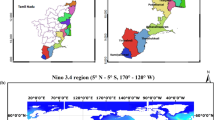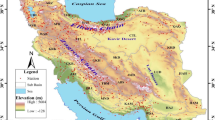Abstract
The predictions of extreme events by the Unified Forecast System (UFS) Coupled Model Prototype 5 of the National Centers for Environmental Prediction over the contiguous United States during boreal summer are assessed. The extreme events in precipitation and daily maximum and minimum surface air temperature in weeks 1–4 predictions are analyzed in the deterministic retrospective forecasts of UFS during 2011–2017. The spatial structures of the extreme events in precipitation are reasonably well predicted but with higher values. Although the predictions of the temperature are closer to observation over central and eastern parts of the US, the model fails to generate the extreme events over large western regions. There is no appreciable growth of forecast errors of extreme events during weeks 1–4. While the spatial correlation of the number of extreme events between the forecasts and observation is very low for precipitation and temperature, the correlation of the temperature per event is very high. The model is able to better predict the observed location and magnitude of temperature events whenever it can generate such events. The number of precipitation events in the forecasts is higher than in the observation but with less accuracy in location and magnitude. The influence of slowly varying modes related to El Niño-Southern Oscillation (ENSO), intraseasonal oscillation (ISO) and warming trend of the ocean on the extreme events are also studied. All three modes have enhancing influence on precipitation while only the ENSO mode enhances the maximum temperature events. The minimum temperature events are enhanced by ENSO and ISO but diminished by the warming trend.














Similar content being viewed by others
References
Abatzoglou TJ (2016) Contributions of cutoff lows to precipitation across the United States. J Appl Meteorol Climatol 55:893–899
Adcroft A et al (2019) The GFDL Global Ocean and Sea Ice Model OM40) model description and simulations features. J Adv Model Earth Syst 11:3167–3211
Angel L et al (2015) Climatology of daily precipitation and extreme precipitation events in the Northeastern United States. J Hydrometeorol 15:2537–2557
Barlow M et al (2019) North American extreme precipitation events and related large-scale meteorological patterns: a review of statistical methods dynamics modeling and trends. Clim Dyn 53:6835–6875
Clark RT, Brown SJ, Murphy JM (2006) Modeling Northern Hemisphere summer heat extreme changes and their uncertainties using a physics ensemble of climate sensitivity experiments. J Clim 19:4418–4435
Dee DP et al (2011) The ERA-Interim reanalysis: configuration and performance of the data assimilation system. Q J R Meteorol Soc 137:553–597
Dirmeyer PA (2000) Using global soil wetness dataset to improve seasonal climate simulation. J Clim 13:2900–2922
Gao Y, Leung LR, Zhao C, Hagos S (2017) Sensitivity of US summer precipitation to model resolution and convective parameterizations across gray zone resolutions. J Geophys Res Atmos 122:2714–2733
Ghil M et al (2002) Advanced spectral methods for climatic time series. Rev Geophys 40(1):1003. https://doi.org/10.1029/2000RG000092
Grotjahn R et al (2016) North American extreme temperature events and related large scale meteorological patterns: a review of statistical methods dynamics modeling and trends. Clim Dyn 46:1151–1184
Higgins WY, Yao Y, Yarosh ES, Janowiak JE, Mo KC (1997) Influence of the Great Plains low-level jet on summertime precipitation and moisture transport over the central United States. J Clim 10:481–507
Huang H et al (2021) Sources of subseasonal-to-seasonal predictability of atmospheric rivers and precipitation in the western United States. J Geophys Res Atmos 126:e2020JD034053. https://doi.org/10.1029/2020JD034053
Jones C (2000) Occurrence of extreme precipitation events in California and relationship with the Madden-Julian Oscillation. J Clim 13:3576–3587
Jones C, Gottschalck J, Carvalho LMV, Higgins WR (2011) Influence of the Madden–Julian oscillation on forecasts of extreme precipitation in the contiguous United States. Mon Weather Rev 139:332–350
Klotzbach PJ, Oliver ECJ, Leeper RD, Schreck CJ (2016) The relationship between the Madden–Julian Oscillation (MJO) and Southeastern New England snowfall. Mon Weather Rev 144:1355–1362
Koster RD et al (2004) Regions of strong coupling between soil moisture and precipitation. Science 305:1138–1140
Krishnamurthy V et al (2021) Sources of subseasonal predictability over CONUS during boreal summer. J Clim 34:3273–3294
Lin H, Mo R, Vitart F, Stan C (2019) Eastern Canada flooding 2017 and its subseasonal predictions. Atmos Ocean 57:195–207
Mei R, Wang G (2012) Summer land-atmosphere coupling in the United States: comparison among observations reanalysis data and numerical models. J Hydrometeorol 13:1010–1022
Prein AF, Rassmussen RM, Ikeda K, Liu C, Clark MP, Holland GJ (2017) The future intensification of hourly precipitation extremes. Nat Clim Change 7:48–52
Seneviratne SI et al (2012) Changes in climate extremes and their impacts on the natural physical environment. In: Field CB, V Barros V, Stocker TF, Qin D, Dokken DJ, Ebi KL, Mastrandrea MD, Mach KJ, Plattner G-K, Allen SK, Tignor M, Midgley PM (eds) Managing the risks of extreme events and disasters to advance climate change adaptation. A special report of working groups I and II of the intergovernmental panel on climate change (IPCC). Cambridge University Press, Cambridge, pp 109–230
Singh D, Tsiang M, Rajaratnam B, Diffenbaugh NS (2013) Precipitation extremes over the continental United States in a transient high-resolution ensemble climate model experiment. J Geophys Res Atmos 118:7063–7086. https://doi.org/10.1002/jgrd.50543
Srivastava A, Grotjahn R, Ullrich PA (2020) Evaluation of historical CMIP6 model simulations of extreme precipitation over contiguous US regions. Weather Clim Extremes 29:100268. https://doi.org/10.1016/j.wace.2020.100268
Stan C, Lin H (2019) Introduction to the special issue of the Year of Tropics-Midlatitude Interactions and teleconnections (YTMIT). Atmos Ocean 57:157–160. https://doi.org/10.1080/20507828.2019.1653032
Stan C, Straus DM, Frederiksen JS, Lin H, Maloney ED, Schumacher C (2017) Review of tropical-extratropical teleconnections on intraseasonal time scales. Rev Geophys 55:902–937. https://doi.org/10.1002/2016RG000538
Vecchi GA, Bond NA (2004) The Madden-Julian Oscillation (MJO) and the northern high latitude wintertime surface air temperatures. Geophys Res Lett 31:L04104. https://doi.org/10.1029/2003GL018645
Vitart F, Robertson AW (2018) The sub-seasonal to seasonal prediction project (S2S) and the prediction of extreme events. npj Clim Atmos Sci 1:3. https://doi.org/10.1038/s41612-018-0013-0
Vitart F et al (2016) The subseasonal to seasonal (S2S) prediction project database. Bull Am Meteorol Soc 98:63–173
Xie P, Chen M, Shi W (2010) CPC unified gauge-based analysis of global daily precipitation. Preprints 24th Conference on Hydrology Atlanta GA American Meteorological Society https://ams.confex.com/ams/90annual/techprogram/paper_163676.htm
Zhang J, Wang WC, Leung LR (2008) Contribution of land-atmosphere coupling to summer climate variability over the contiguous United States. J Geophys Res Atmos 113:D22109. https://doi.org/10.1029/2008JD010136
Zhou S, L’Heureux M, Weaver S, Kumar A (2012) A composite study of the MJO influence on the surface air temperature and precipitation over the Continental United States. Clim Dyn 38:1459–1471
Zhu X, Stan C (2015) Projection of summer precipitation over the southeastern United States in the superparameterized CCSM4. J Clim 28:8052–8066
Acknowledgements
This work was supported by the National Oceanic and Atmospheric Administration (grant NA18NWS4680069) and by the Unified Forecast System Research to Operation (UFS R2O) Project which is jointly funded by NOAA’s Office of Science and Technology Integration (OSTI) of National Weather Service (NWS) and Weather Program Office (WPO), [Joint Technology Transfer Initiative (JTTI)] of the Office of Oceanic and Atmospheric Research (OAR) through the NOAA grant NA19NES4320002 (Cooperative Institute for Satellite Earth System Studies-CISESS). Data used in this study are publicly available at https://registry.opendata.aws/noaa-ufs-s2s/. The authors thank three anonymous reviewers for helpful comments.
Author information
Authors and Affiliations
Corresponding author
Ethics declarations
Conflict of interest
The authors declare no conflict of interest.
Additional information
Publisher’s Note
Springer Nature remains neutral with regard to jurisdictional claims in published maps and institutional affiliations.
Supplementary Information
Below is the link to the electronic supplementary material.
Rights and permissions
About this article
Cite this article
Krishnamurthy, V., Stan, C. Prediction of extreme events in precipitation and temperature over CONUS during boreal summer in the UFS coupled model. Clim Dyn 59, 109–125 (2022). https://doi.org/10.1007/s00382-021-06120-0
Received:
Accepted:
Published:
Issue Date:
DOI: https://doi.org/10.1007/s00382-021-06120-0




